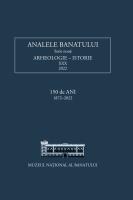Tipuri de cercei din secolele VII-VIII descoperiți pe teritoriul Transilvaniei
7th and 8th century
earring types discovered within the territory of Transyilvania
Author(s): Călin CosmaSubject(s): Archaeology, Local History / Microhistory, 6th to 12th Centuries
Published by: Editura Mega Print SRL
Keywords: typology Early Middle Age; Transylania; chronology; earrings;
Summary/Abstract: The article presents earrings from the 7th-8th centuries, discovered within the territory of Transylvania. The earrings were found in Avar cemeteries, in Slavic-Avar bi-ritual cemeteries as well as in settlements. Most earrings come from Avar graves, compared to those in bi-ritual cemeteries. The number of earrings is extremely small, both at the level of all the bi-ritual cemeteries in the Transylvanian Plateau and at the level of each particular archeological site. Earrings were discovered in only five settlements in Transylvania. Various types of earrings have been discovered in Transylvania, from the simplest ones that are ring-shaped, sharpened at the ends and made of wire or round bar, to those with a stellar pendant or earrings with a moon-shaped pendant. Almost all the artifacts have analogies in the territory of the Avar Khaganate in the Carpathian Basin but also in the area of the Lower Danube basin and in Bulgaria. The presence of earrings in graves is due, in part, to the fact that the deceased were buried with all the clothing accessories and adornments, including the earrings that one wore during one's life. On the other hand, the presence of earrings in graves and the custom of depositing these objects in funeral complexes are due to the deposits made by the families of the deceased at the time of their burial. The earrings were worn by women and to a lesser extent by men and children.
Journal: Analele Banatului S.N. Arheologie-Istorie
- Issue Year: XXX/2022
- Issue No: 1
- Page Range: 93-137
- Page Count: 45
- Language: Romanian

